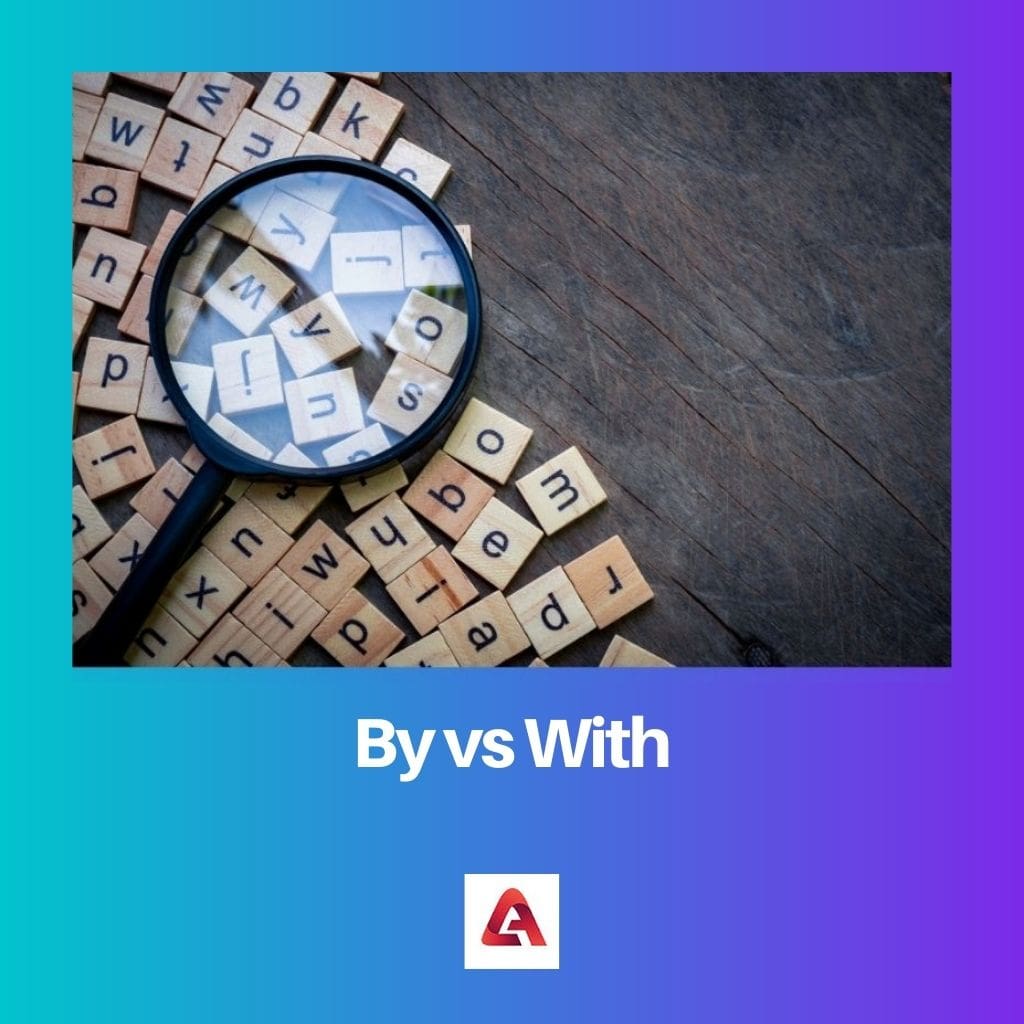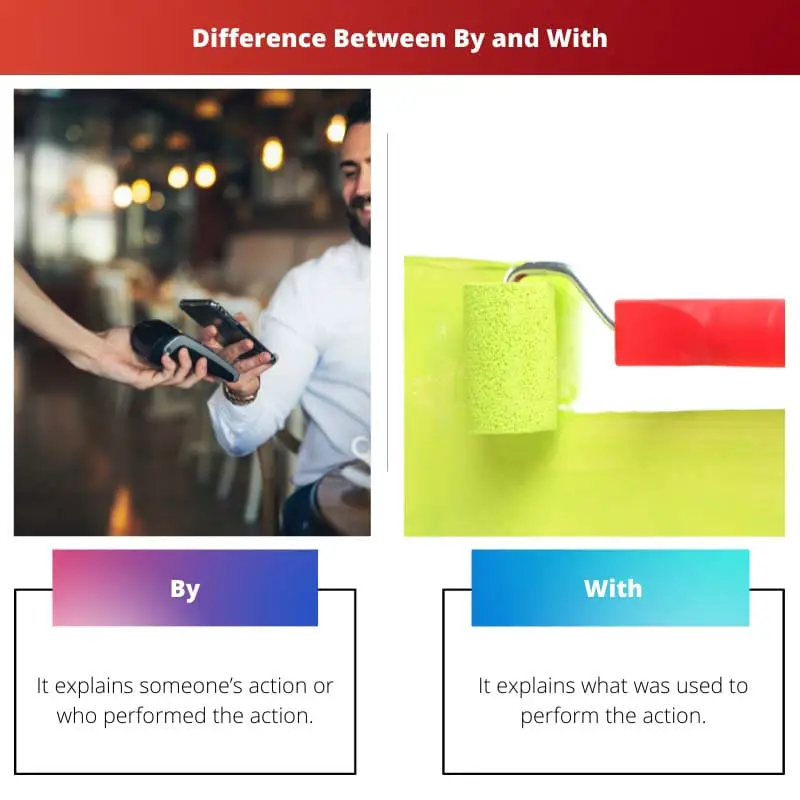“By” typically indicates the means or method through which an action is accomplished, emphasizing the agent or instrument involved. For example, “The painting was created by the artist.” “With,” on the other hand, suggests association or accompaniment, indicating the presence of something or someone alongside another. For instance, “He wrote the letter with a pen.”
Key Takeaways
- “By” is a preposition used to indicate the agent or means of an action, while “with” is a preposition used to denote accompaniment, manner, or instrumentality.
- “By” can show who or what acted, whereas “with” emphasizes involvement or association in an action or event.
- Both “by” and “with” function as prepositions in sentences but serve different purposes: “by” focuses on the agent or means of an action, while “with” highlights accompaniment or instrumentality.
By vs. With
“By” is used to show the agent or means of an action, indicating the person, object, or method that is responsible for or performs the action. “With” is used to show accompaniment, association, or the means by which something is done, used to accomplish a task or the person accompanying someone.

By and with both are prepositions. By and with can show how something can be done. By and with play different roles in the active and passive voice; sometimes by can replace by with, in passive-voice sentences.
Active voice sentences most of the time by follows a verb, whereas with follows a noun.
Active voice means the subject performs the verb’s action, and passive voice means the matter acted by a verb. By is a preposition and acts as an adverb, adjective, and noun sometimes.
By indicating who acts. With is also a preposition, which means express and what was used to work.
Comparison Table
| Feature | By | With |
|---|---|---|
| Function | Primarily a preposition with various uses, including: * Denoting means or method: accomplish something by working hard. * Denoting agent: The work was done by her. * Denoting location (in proximity): He stood by the window. | Primarily a preposition with various uses, including: * Denoting accompaniment: He went to the store with his friend. * Denoting instrument or means: She wrote the letter with a pen. * Denoting manner: He treated her with kindness. * Denoting possession: The vase with flowers is on the table. |
| Emphasis | Can emphasize the means, method, agent, or location. | Can emphasize companionship, instrumentality, manner, or possession. |
| Examples | * The cake was made by my grandmother. (agent) * They traveled by train. (means) * I live by the park. (location) | * He went to the store with his friend. (companionship) * She wrote the letter with a pen. (instrument) * He treated her with kindness. (manner) * The vase with flowers is on the table. (possession) |
When to Use By?
Understanding “By” Usage
1. Agent of Action:
- “By” is used to indicate the agent or doer of an action.
- It specifies who or what is responsible for performing the action.
- Example: “The book was written by Mark Twain.” (Mark Twain is the agent who wrote the book.)
2. Means or Instrument:
- “By” is employed to denote the means or instrument through which an action is carried out.
- It indicates the method, tool, or mechanism utilized for accomplishing a task.
- Example: “She cut the paper by using scissors.” (Scissors serve as the instrument for cutting the paper.)
3. Passivity:
- “By” is used in passive voice constructions to highlight the agent when the focus is on the action itself rather than the doer.
- It shifts attention to what is being done rather than who is doing it.
- Example: “The meal was prepared by the chef.” (Emphasizing the action of meal preparation rather than the chef.)

When to Use With?
Understanding “With” Usage
1. Instrumentality:
- “With” is used to denote the instrument or tool utilized to perform an action.
- It highlights the means through which an action is accomplished.
- Example: “He wrote the letter with a pen.” (The pen is the instrument used for writing.)
2. Accompaniment:
- “With” indicates the presence or companionship of someone or something during an action.
- It signifies association or being together with another entity.
- Example: “She went to the park with her friends.” (Her friends accompanied her to the park.)
3. Manner or Condition:
- “With” can denote the manner in which an action is performed or the condition in which it occurs.
- It describes the state or circumstance accompanying the action.
- Example: “He spoke with confidence.” (Confidence describes the manner in which he spoke.)

Main Differences Between By and With
- Agent vs. Instrument/Means:
- “By” emphasizes the agent or doer of an action, highlighting who or what performs the task.
- “With” focuses on the instrumentality or means used to accomplish an action, indicating the tool or method utilized.
- Passive Voice vs. Active Voice:
- “By” is commonly used in passive voice constructions to highlight the agent when the focus is on the action itself rather than the doer.
- “With” is typically used in active voice constructions to denote the instrument or companion involved in the action.
- Association vs. Accompaniment:
- “By” signifies association with the agent or means through which the action is performed.
- “With” indicates the presence or accompaniment of someone or something during the action, highlighting companionship or association.

- https://dictionary.cambridge.org/dictionary/english/by
- https://dictionary.cambridge.org/dictionary/english/with

The comparison table is well-structured, making it easy to understand the points of difference. Clear and concise.
Yes, the comparison table is quite helpful.
I found the repetition of how ‘by’ can be used slightly redundant. The examples could have been better varied.
I agree. The article could have incorporated a broader range of examples.
This article was a bit dry. I appreciate the information, but there’s certainly room for improvement in style.
I agree that the writing style could benefit from some improvements.
How enthralling, a guide to mastering ‘by’ and ‘with’! A well-written and interesting read.
Yes, I’m so glad I came across this. It’s a fantastic resource.
I agree! Coveted for how comprehensive and systematic it was.
I found the information to be very comprehensive. The various contexts for ‘by’ and ‘with’ you’ve included were particularly helpful.
Yes, I thought the same. The article feels comprehensive.
Agreed, I’m glad for the additional, real-life examples of usage that were given.
This is rather informative, but I think this could have been a bit more engaging. A pragmatic approach, nevertheless.
Yes, I agree. Perhaps a more interactive format would hold readers’ attention better.
I see your point. I’d love to get some elaboration on the subject.
Frankly, this was overcomplicated. It was tough to stay invested. Simplifying the language and structure could do wonders.
Fully agree. A more straightforward approach would hold my attention better.
What a well-constructed guide to differentiating between ‘by’ and ‘with’. It’s clear and concise, providing useful examples. I feel more informed on preposition use.
I agree. This was very interesting. I had never thought of the active and passive voice differences like this before.
I will definitely be checking on this the next time I use a preposition in a sentence.